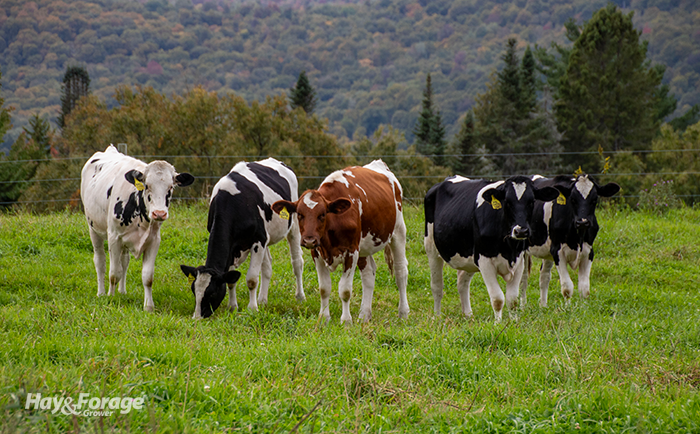Grazing heifers are the new cash cows |
| By Amber Friedrichsen, Managing Editor |
|
|
 Raising replacement heifers can be costly for a dairy farm, with feed costs for these animals typically comprising the biggest chunk of that expense. One solution is to let heifers harvest forage themselves, which can not only offset feed costs but may benefit milk production and the environment. In a recent issue of the Midwest Forage Association’s Clippings newsletter, David Jaramillo and Kenneth Kalscheur with the U.S. Dairy Forage Research Center and Carlos Camisa Nova with the University of Wisconsin-Madison promote grazing replacement heifers after comparing this approach to raising animals solely in confinement. The main objectives of their research were to evaluate the long-term effects grazing had on milk production and the economic implications of the practice. Weight gain goals The researchers suggest feeding regimens for replacement heifers generally allow animals to reach about 60% mature body weight at breeding, or between 13 to 15 months of age, and nearly 90% mature body weight at calving, or 22 to 24 months of age. While meeting these goals has been shown to benefit subsequent milk production, heifers that don’t hit these targets may experience inadequate gains, and thus delayed breeding and calving, which inherently raises feed costs even further. That being said, grazing heifers has potential to offset high feed costs, especially in regions like the Upper Midwest where high-quality, cool-season grass and grass-legume pastures can meet the needs of growing heifers with little to no supplementation. There are also environmental benefits of expanding perennial pasture acres, such as reduced soil erosion, less nutrient loss, and greater carbon sequestration, creating a win-win situation for dairy farmers. To demonstrate this, the researchers divided 18 heifers between cool-season grass pastures and a freestall barn where they were fed a total mixed ration (TMR). Pasture-raised heifers grazed from May to September during two consecutive years, whereas those in the freestall barn remained there throughout the duration of the experiment. More milk on grass After the second grazing season, the researchers collected data for milk production and composition, feed intake, and body weight at 50, 100, 150, and 200 days in milk (DIM). Pasture-raised heifers produced more milk than those continuously raised in confinement; however, milk components on a percentage basis, feed efficiency, and body weight were not different between treatments. Even so, higher total milk production resulted in greater total milk protein from the pasture-raised heifers on a pounds per day basis. The calculated income over feed costs was $1.76 more per day for pasture-raised heifers ($12.80) than for those raised in the free stall barn ($11.04). “Thus, the economic advantages are evident when heifers are raised on pasture compared to confinement, without deleterious effects on growth and performance,” the authors write. They contend that the results of the study support two of the most important aspects of a dairy operation: production, considering the higher milk volume from pasture-raised heifers during their first lactation, and economics, considering better income over feed costs realized in the grazing treatment. The researchers state that the results raised subsequent questions surrounding the physiological mechanisms that drive higher milk production from pasture-raised heifers. A follow-up study is currently underway at the University of Wisconsin’s Marshfield Agricultural Research Center to further examine those factors. “Understanding these mechanisms and truly understanding what leads to greater milk production can help us make better management recommendations that maximize gains to dairy producers, making them more sustainable over time,” the authors conclude. |
